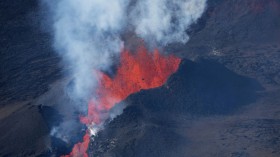A previously unknown "fourth strand" of European ancestry was recently revealed in a study led by researchers from the University of Cambridge. This missing puzzle piece was identified when sequencing ancient genomes of human remains that date back to the Late Upper Palaeolithic period over 13,000 years ago. Researchers found that the new lineage stems from ancient populations of hunter-gatherers who moved out of Africa and traveled north into parts of Caucasus 45,000 years ago.
Following the "out of Africa" expansion, hunter-gathers remained isolated during the last Ice Age, though the mountains of Caucasus – where the countries of Georgia and Russia meet today – provided much-needed shelter until warming temperatures allowed for travel. As the world finally began to thaw, hunter-gatherers began crossing paths with other populations. Ultimately, this led to increased genetic diversity and the Yamnaya culture was born, according to a news release.
"The question of where the Yamnaya come from has been something of a mystery up to now," Dr. Andrea Manica, one of the study's lead senior authors from Cambridge's Department of Zoology, said in the release.
The Yamnaya culture is characterized by horse-borne Steppe herders that swept into Western Europe around 5,000 years ago. Presumably, the Yamnaya are responsible for the start of the Bronze Age and early animal herding techniques. Nonetheless, the ancestral DNA of Caucasus hunter-gatherers can be found in almost all European descendants today.
"We can now answer that as we've found that their genetic make-up is a mix of Eastern European hunter-gatherers and a population from this pocket of Caucasus hunter-gatherers who weathered much of the last Ice Age in apparent isolation. This Caucasus pocket is the fourth major strand of ancient European ancestry, one that we were unaware of until now," Manica added.
Previously, scientists believed ancient Eurasian genomes stemmed from only three ancestral populations. However, the recent sequencing of ancient DNA recovered from Western Georgia reveals that Yamnayas owe much of their ancestry to the newly identified fourth Caucasus hunter-gatherer strand.
"We knew that the Yamnaya had this big genetic component that we couldn't place, and we can now see it was this ancient lineage hiding in the Caucasus during the last Ice Age," Manica explained.
Additionally, researchers found that Caucasus hunter-gatherer ancestry had a significant influence further east. This suggests a similar population must have migrated into South Asia at some point and the Caucasus region acted as a primary migratory route for early hunter-gatherers, researchers noted.
"The sequencing of genomes from this key region will have a major impact on the fields of palaeogeneomics and human evolution in Eurasia, as it bridges a major geographic gap in our knowledge," Professor Ron Pinhasi, a lead senior author from University College Dublin, said. "The Caucasus region sits almost at a crossroads of the Eurasian landmass, with arguably the most sensible migration routes both west and east in the vicinity."
This study, recently published in the journal Nature Communications, represents the first genetic sequence collected from Georgia. Researchers hope to unveil more palaeogenetic information from the area's rich fossils in the future.
Related Articles
Fossil Teeth Suggest Early Humans Settled In China First, Not Europe, Researchers Say
For more great nature science stories and general news, please visit our sister site, Headlines and Global News (HNGN).
-Follow Samantha on Twitter @Sam_Ashley13
© 2024 NatureWorldNews.com All rights reserved. Do not reproduce without permission.





